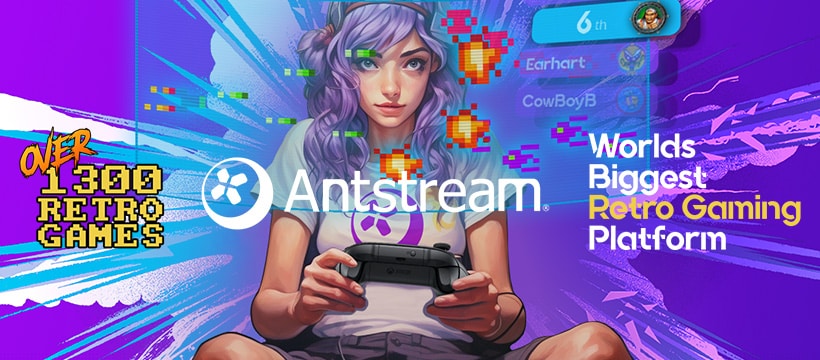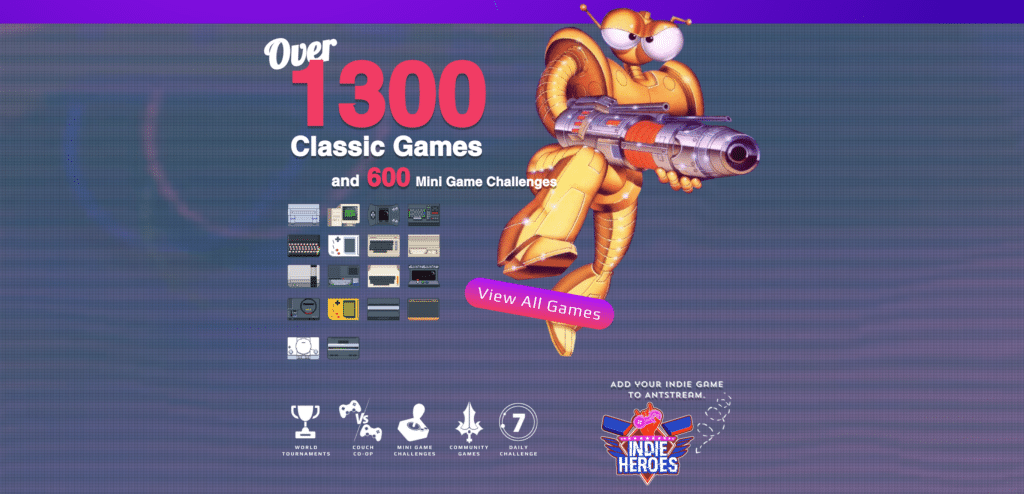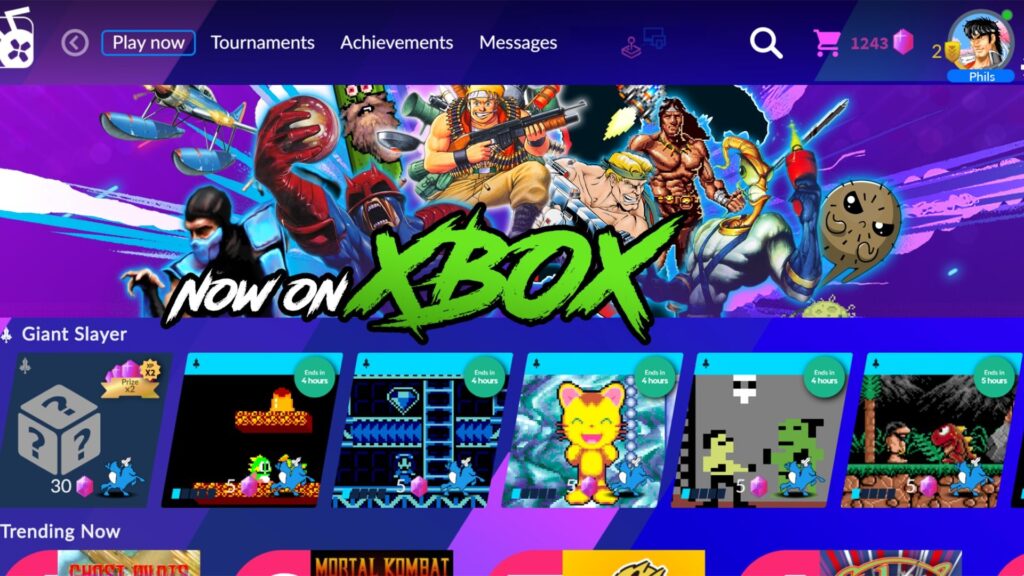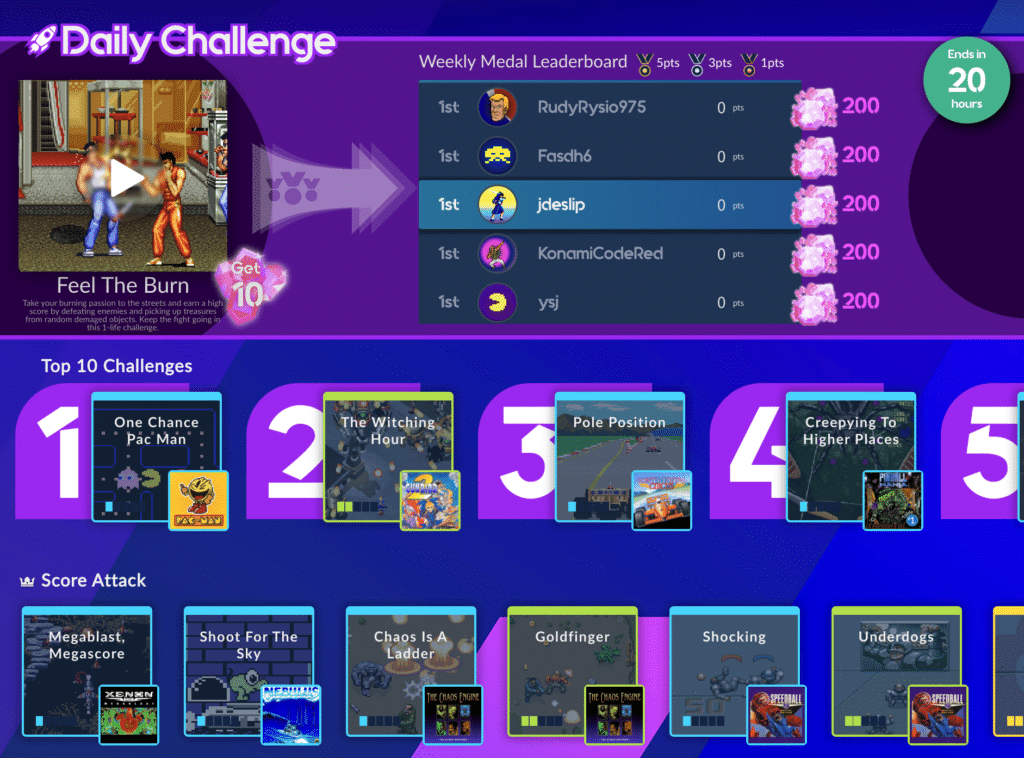
We have been granted a fantastic opportunity to interview the founder and CEO of Antstream Arcade – our absolute favorite way to play retro-games (over 1000 of them!) on all our screens. This interview was an opportunity to learn more about the cloud based retro gaming service and the technology that powers it.
There are a lot of great tidbits in this interview – for example the tip that Antstream is expanding to new territories and new devices soon! That has us excited.
Here is the full Q&A text. We hope you enjoy it as much as we did.
Can you please introduce the service and yourself for our readers?
Hi, my name is Steve Cottam and I am founder and CEO of Antstream. Antstream is a cloud gaming platform that allows players to play and compete in a massive library of more than 1300 retro games from various devices such as the Arcades, Atari 2600, Commodore 64 and Amiga, Sega Genesis, and more, across multiple devices, from Xbox and PC to mobile devices.
Antstream operates on a subscription-based model similar to Netflix and Spotify. For a small annual fee users get access to the entire library of games. A yearly subscription is just £39.99/$39.99, or for a limited time users can take advantage of a one-off lifetime subscription for only £99.99. Alongside playing the games how they were originally envisioned, albeit with the chance to save and quit at any point without losing progress, players can also access tournaments, challenges and leaderboards to compete against the community.
You all appear to have a passion for retro-gaming. What drives that love for retro gaming?
It’s not just me, the entire AntTeam have a passion for retro gaming and are passionate about creating retro gaming experiences that will appeal to all gamers, new and old.
There is a disparity between video games and other forms of media. While someone can quite easily find movies, music or TV shows from 10, 20, 30 years ago, finding and playing video games from those eras is far more difficult. Tracking down the original hardware and software, in working order, is prohibitively expensive, while the murky world of emulation and roms can be fraught with risks. Our goal at Antstream is to ensure that these older games are available for anyone to play at any time, and that the content owners get rewarded.
Also, there is something to be said for game preservation. The video game industry is still relatively young, but so much of the creativity of the early days of game development has already been lost. With the Antstream platform, we try to ensure these games will be available for future generations and prevent them from disappearing forever.

What sort of trends are you seeing in cloud gaming? Have you seen growth in your player base and/or in the people interested in the space as a whole?
Recent years have seen Internet speeds and reliability improve dramatically, which has given rise to the concept of cloud gaming. The concerns that many people would have had in relying on their internet connection to stream video games have more or less gone, and the cloud gaming sector is growing rapidly as a result. Most people want simplicity above all else and being able to stream a video game without worrying about hardware limitations or compatibility is incredibly attractive.
For Antstream, streaming retro games to user’s devices requires relatively low resources, compared to a AAA HD game, allowing us to offer a very reliable service even on relatively slow connections. We are proud to have the world’s largest cloud gaming catalogue and the world’s largest officially licensed retro gaming service. What really excites us is the increasing number of younger gamers discovering these classic titles through Antstream for the first time. These gamers have been introduced to gaming through far more complex, yet often simpler, titles across the various more recent consoles and are only now finding the joy of playing games like Bubble Bobble or R-Type.
The cost of hosting cloud services is not free. Can you comment on the challenges and opportunities in running a cloud gaming service and how you do so sustainably.
There are many challenges in running a cloud gaming service like Antstream. High infrastructure costs for powerful servers, low-latency network and ensuring scalability during peak times to name a few. Unlike other providers that may have long wait times, we believe a game should start almost instantly and achieving a seamless gaming experience involves minimising latency which is crucial for real-time gameplay. We address these challenges in part by strategically locating data centers near users. Our system utilises advanced compression algorithms, and robust error-correction mechanisms to deliver a perfect stream. Additionally, we are continuously refining our game emulators to use less CPU thus enhancing efficiency and increasing the number of sessions each server can handle.
Technological advancements in virtualization and containerization help us optimise resource usage and control costs. We also constantly monitor data and metrics to improve both the gaming experience and operational efficiency.
Opportunities for sustainable growth include adopting subscription models for consistent revenue, leveraging technologies like edge computing to enhance service and reduce costs, and expanding into new markets and platforms to broaden our user base. We leverage analytics for resource management and focus on user experience enhancements to boost retention. These efforts help us maintain a competitive edge and ensure long-term sustainability in the cloud gaming market.
Can you describe (in as much detail as you are able to provide publicly) your cloud gaming architecture? In particular, our readers are often interested in knowing the following:
Number and locations of your data-centres and/or edge facilities. Do you use your own hardware or leverage commercial cloud offerings?
We are cloud agnostic, so run game servers on multiple services such as AWS and Azure to improve redundancy and costs wherever possible. We run multiple hubs in each of the following regions: Europe, US, South East Asia, Brazil and Australia
Node level hardware including CPU, GPU specifications, memory specs and storage specifications (on-node and/or networked)
Servers typically contain a minimum of 16 CPU cores, 32GB Memory, 100GB Disk
Codecs used and available resolutions, frame rates
We use a range of codecs with resolutions from QCIF to HD depending on the games. We are passionate about maintaining the frame rates and the maximum fidelity of retro content which are 50-60FPS.
Supported end user devices
We are on Windows, Mac, Linux, Android, Xbox, Samsung TV and Web.
Any other novel aspects of your cloud gaming architecture that you’d like to highlight
We recently shifted from using a third-party game services provider for player and account management to developing our own tailored system from scratch. Our current infrastructure is based on a fully serverless, event-driven microservice architecture. This allows us to tailor the infrastructure specifically to our needs and has significantly enhanced both cost-efficiency and operational simplicity. Scaling issues are now obsolete, and the day-to-day management of the infrastructure requires minimal effort. This transformation has shifted our focus more towards game development and innovation, enabling us to react more swiftly and effectively to new opportunities or challenges.
The effectiveness of our new setup was evident during our smooth Xbox launch. The assurance that a crucial aspect of our technology stack—particularly server scalability and reliability—would perform flawlessly offered considerable peace of mind throughout the rollout. This experience underscores the reliability and strength of our revamped infrastructure.
Do you have any plans to further the reach of your service, to more territories or perhaps to more smart devices, such as more models of Smart TV OS
There will be official announcements coming, but we are releasing in new territories very soon, plus we will be launching on at least two more major platforms this year.

Since you launched on Xbox, do you have plans to launch on PlayStation or Nintendo consoles as well?
Our goal is to allow Antstream subscribers to play their favourite retro titles on any device, so we are always pushing to bring the service to every platform we can. Some platforms will prove to be more difficult than others to launch on, but we continue working towards players being able to get their retro fix anywhere. There are a few clues dotted around if you look for them.
How do you curate and control the games that you release onto the service? Do you have the support of the publishers for each game released? Or are you operating in more of a “Virtual PC” model?
All of our games have the full support of the publishers or developers who own the licenses.
We’ve noticed that Antstream has lost access to 100+ games over the past year. We know licensing issues can be complex, but can you comment on the issues at play here and whether game rotation is expected to be common place on the service going forward?
This can be for a number of reasons. Sometimes it can be because we have a certain budget and we need to make a tough choice, othertimes the IP owners may have their own strategic reason for their content. It can be disappointing when games leave the service, but we are constantly adding new games, and there are many games set to return to the plarform over the course of the next year.
Are you in talks with any other developers or publishers to secure their games for your service?
While we can’t discuss openly while talks are ongoing, there are always developers and publishers that we are trying to work with to bring their games to Antstream. Licensing is complex, but we continue to try and secure as many games as possible for our subscribers. We are doing a lot to support the incredible indie scene that is creating new games for original hardware formats. Games like Flea, Reshoot-R and Demons of Asteborg really showcase what talented developers can squeeze out of original hardware like the Nes, Amiga, MegaDrive and others.

The definition of “retro” is a bit of a moving target. Do you see Antstream adopting games from the PlayStation 2 and Xbox/Xbox 360 generation of consoles?
It’s a rolling target with every year that passes. There are also new games with a retro style that we think could be a good fit.
With that said though, there are currently plenty of games that we are still chasing down to include on the Antstream platform from the 70s, 80s and 90s. Development and publishing was quite chaotic back in the early days of video games, and trying to find license holders can be difficult. Our mission is to enable gamers to experience and enjoy as many of these classic titles as possible on their favourite devices.
Also, while our focus is on the retro titles that older gamers would remember from those early platforms, Antstream are adding “new retro” games to the service. Titles like Chew Chew Mimic and Demons of Asteborg are newly developed on retro platforms. The retro indie scene is stronger than ever and will undoubtedly bring more new and exciting titles to Antstream. This new breed of developers really showcases what can be squeezed out of original hardware.
Many thanks for taking part in this interview. Is there anything else you would like to add?
This is just a great big thank you to all of our subscribers. The faster the service grows, the more games we can add. Reading the positive comments from the fans always gives the team a boost and makes the hard work worthwhile.
Advertisement

